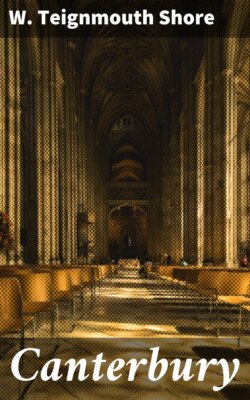Читать книгу Canterbury - W. Teignmouth Shore - Страница 5
The Interior
ОглавлениеThe best way to obtain a fair view of the beautiful proportions of the nave and of the most striking picture of the interior of the church, is to enter by the south-west door or porch. Here in Saxon days courts of law were held, cases being tried which could not be referred to other courts. Prior Chillenden about 1400 built the
THE CHAPEL OF “OUR LADY” IN THE UNDERCROFT, CANTERBURY CATHEDRAL
present fine porch; he was a man of energy, and to him and to those whom he inspired to do his biddings Canterbury owes a great debt. Erasmus has described for us the figures that used to occupy the panel above the entrance, the effigies of Becket’s murderers, who, he says, go down to the ages with much the same ill-name as that which pertains to Pilate, Judas and Caiaphas. Some vague fragments of the carving still survive, including an altar, probably that of the Martyrdom. In the vaulting of the porch are various coats-of-arms, among them those of the Sees of Canterbury and Chichester, and of the kingdoms of England and of France. In accordance with an idea suggested by Dean Alford, some of the niches here and on the west front have been filled in recent days with statues of men of note who in one way or another have been connected with the history of the Cathedral.
They are solemn stones, or rather it is solemn ground this, over which we pass, “where the saints have trod”—saints, soldiers, ecclesiastics, Christians all in their several degrees, from dim Saxon days down to this present moment.
Now, we enter the nave.
Somewhat cold, somewhat unearthly almost, is the impression made by the forest of pillars rising through the clerestory to the vaulted roof; stretching away to the central tower—Bell Harry—where light shines down into the gloom. A beautiful place wherein to rest and dream dreams of the past. All now is grey, but in bygone ages the great church blazed with colours; paintings and rich hangings adorned the walls; there were numberless altars with their tiny points of light, and all was enriched and at the same time mellowed by the splendour shed upon pavement and pillar from the “storied windows richly dight.” Who shall say whether the change from pomp to simplicity be for better or for worse? As with so many other matters in this opinionative world, it all depends upon the point of view; doubtless to the stern ascetic the rule that now obtains is for the best; upon the superstitious pilgrim of old the glories of the past assuredly had their influence. Yet, why think of what has gone, when that which remains is so worthy?
The nave dates from about 1378 to 1411, in which last year the builder of it, the aforementioned Prior Chillenden, died, “who after nobly ruling as Prior of this church for twenty years twenty-five weeks and five days,” says his epitaph, as given by Willis, “at length on the day of the Assumption of the Blessed Virgin Mary closed his last day.” As it was written of Christopher Wren, so here it might be of Chillenden—“If monument be asked for, look around.” The architecture here is Perpendicular, contrasting exquisitely with the early work of the choir; it is no new simile—but there is no call to provide a new when the old is so good—to say that these splendid pillars, rising from their firm, fixed roots in the stony floor and springing up into the grey heights far above, strike deep upon the imagination as being akin to the glorious pillars of a stately forest.
A curious and oft-repeated error is to say that Canterbury is unique among churches, in that from the nave we look up to the choir, the latter being raised on the crypt. A precisely similar cause and effect are to be found, for example, at Worcester.
The stained glass which once adorned the nave, is gone, smashed by zealous Puritans, and all of olden colour that we now see is in the great west window, compiled of fragments from those that have departed.
Of the tombs and monuments in the nave the most noteworthy are in the north aisle—those of Charles the First’s famous organist, Orlando Gibbons; of Sir John Boys, founder of the hospital for the poor near the North Gate of the city; and the altar tomb of Archbishop Sumner. Also to be noted, a window to the memory of Dean Stanley, sometime canon of the Cathedral and writer of that famous work, Historical Memorials of Canterbury.
As we stand in the choir of to-day, we would indeed be of dull imagination did we not see and drink in the poetic beauty of such a growth as this, beautiful in its association with the centuries, with countless thousands of worshippers; beautiful intrinsically and as a record of faithful labour, of splendid artistry, of devout perseverance. There are other cathedral choirs more perfect as specimens of one or other style of architecture, but not one more hallowed by sacred and stirring memories. Here stands Norman and Early English work side by side, melting, as historically they did, from one into the other; the work of French and English hands and brains. Here the mind is forcibly carried back to the far, dim ages, when on this very ground the rude Saxons worshipped—this ground which Augustine found already dedicated to the worship of Christ, upon which he reared his new temple,
